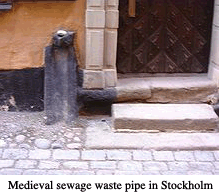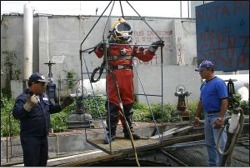|
© Eric R. Pianka  With the advent of agriculture, human populations surged and we began to live in towns
and cities. The problem of disposing of human wastes intensified. By 2700 B.C., some
ancient cities had leakproof plumbing pipe systems. Septic systems were invented. In
some eastern societies such as China and Japan, people collected human waste in "honey pots"
to be recycled as fertilizer.
With the advent of agriculture, human populations surged and we began to live in towns
and cities. The problem of disposing of human wastes intensified. By 2700 B.C., some
ancient cities had leakproof plumbing pipe systems. Septic systems were invented. In
some eastern societies such as China and Japan, people collected human waste in "honey pots"
to be recycled as fertilizer.
Many of the world's major cities are conveniently located along seacoasts, allowing for easy disposal of sewage into the oceans. While it used to be raw sewage, now it's usually variously treated. How can a big city like Los Angeles actually exist? One day's human wastes from LA would fill many Olympic-sized swimming pools. Like all coastal cities, LA originally dumped its sewage into the sea, forming a great undersea alluvial fan that stretches out for miles and is thousands of feet deep. When these massive wastes built up too much, bacteria became a threat to human health, and LA switched to disposing of its treated sewage at a terrestrial facility in Kern County called "Green Acres." When this became too controversial, the authorities switched the disposal area to Kings County. Some cities dump their wastes into large lakes which undergo eutrophication as nutrient levels, especially phosphorus, build up. During this process, a lake changes from being a clear blue oligotrophic lake (nice for boating) to a cloudy, often smelly, brown eutrophic one -- its phytoplankton change as blue green algae take over. This leads to changes in the zooplankton and fish inhabiting the lake. An oligotrophic lake supports desirable fish like trout, whereas only trash fish such as carp can live in a eutrophic lake. The city of Seattle originally dumped its sewage into Lake Washington until that lake became overly enriched causing algal blooms and toxic conditions that led to fish die offs. At its peak, 20 million gallons of treated effluent was dumped into the lake each day. Lake Washington was called "El Stinko." Conveniently, an even larger body of seawater Puget Sound was nearby. From 1963-1968, a massive tunnel was constructed that diverted Seattle's sewage effluent into the ocean. Lake Washington recovered and became a clear oligotrophic lake again, its phytoplankton, zooplankton, and fish returned to their original composition. Most other lakes in the world cannot be restored.  Every year, trillions of gallons of raw sewage are dumped into the world's creeks, rivers,
lakes, and oceans. Sewage plants are strained to capacity and populations are still expanding.
Human wastes are building up.
Every year, trillions of gallons of raw sewage are dumped into the world's creeks, rivers,
lakes, and oceans. Sewage plants are strained to capacity and populations are still expanding.
Human wastes are building up.
How can a huge inland city like Mexico City exist without an ocean to receive its wastes? Reportedly, its 20 million people flush 10,000 gallons a second, enough to fill an Olympic-sized pool every minute! Mexico City has 600 miles of sewer tunnels,  some measuring 20 feet wide dating back
to the ancient Aztecs. These tunnels sometimes get clogged -- then brave sewage divers
must descend into them to clear blockages. On occasion, dead bodies have been discovered
deep in the bowels of Mexico City. some measuring 20 feet wide dating back
to the ancient Aztecs. These tunnels sometimes get clogged -- then brave sewage divers
must descend into them to clear blockages. On occasion, dead bodies have been discovered
deep in the bowels of Mexico City.
In some parts of the world, especially in poor countries in Africa and Asia, sanitation is inadequate. Plastic bags of human feces come flying out of windiws in some cities.Water-borne diseases like cholera can easily become epidemics under such situations. Imagine the sheer volume of the billions of turds produced by all the world's humans each and every day. Sure, many people are starving and won't produce much, many others are mere babies in diapers, but still, that's an awful lot of human faecal matter and it tends to build up over the course of years and decades. Mexico City's Sewage See also Plastics The Human Microbiome Flying Toilets |